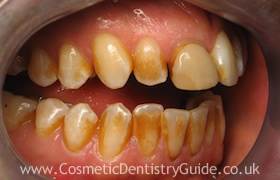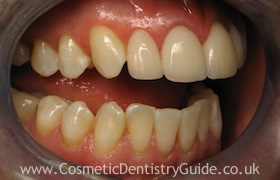Oral hygiene: keeping your teeth clean
- Cost: From £40 for a clean to £1000s for advanced gum treatment
- Treatment length: depends on the case
- Used for: Stained teeth, yellow teeth, discoloured teeth, gum disease
- Available: From most dentists / hygienists
What is oral and dental hygiene?
Oral and dental hygiene refers to the practice of keeping your mouth healthy and clean by following regular and correct brushing and flossing routines. This helps to prevent the formation of plaque, which is the sticky film of bacteria that forms on the hard surfaces of teeth, leading to dental decay and gum disease.
What are the results of good dental hygiene?
A healthy-looking and odourless mouth, which comprises of:
- Clean and debris-free teeth.
- Pink gums that do not hurt or bleed while brushing or flossing.
- A mouth free from regular episodes of bad breath.
What is the purpose of dental hygiene?
Good dental and oral hygiene helps to:
- Prevent the formation of plaque, which is the sticky film of bacteria that forms on the hard surfaces of teeth. This can lead to further dental and oral problems, such as tooth decay, tartar, gingivitis and periodontitis or gum disease.
- Improve quality of life by preserving speech and eating functions, as teeth will last longer and one can avoid the embarrassment of bad breath or missing or unsightly teeth.
What are the symptoms of improper dental hygiene?
- Bleeding or painful gums.
- Persistent bad breath.
- Yellow or brown deposits on teeth.
- Loose teeth and widening gaps between teeth.
What are the potential consequences of improper oral hygiene?
Tooth decay, dental caries, cavities, gum irritation and foul breath - As a result of improper oral hygiene, plaque accumulates on the hard surfaces of teeth; when you eat, the bacteria use the sugar and starch from your food to release acid. This acid:
- Corrodes the tooth enamel over time and results in holes or cavities in the tooth.
- Irritates the gums, resulting in bleeding, which leads to foul breath.
The cavities are usually cleaned and refilled with an inert material by the dentists to retain and restore the teeth as well as protect them from further tooth decay. If left untreated, it can result in loss of entire teeth.
Tartar or calculus - Constant accumulation of plaque as a result of irregular brushing and flossing results in the hardening of plaque into a yellow or brown mineral deposit called tartar or calculus. As a result of its crusty and rough surface, teeth then become ideal locations for further plaque growth. Tartar leads to gum disease when it is formed below the gumline.
Gingivitis - This is the initial stage of gum disease and is characterized by:
- Inflammation of the gums.
- Painless bleeding during brushing and flossing
If treated with adequate dental care, it is reversible. If ignored, it can lead to a more serious and advanced form of gum disease called periodontitis.
Periodontitis. This is advanced gum disease, which leads to the destruction of structures supporting the teeth, including the bone; this causes the loosening of teeth, requiring their removal as a result. The signs of the condition are red, swollen, bleeding gums that shrink away from the teeth. The resulting widening spaces between the teeth and exposed root surfaces are highly vulnerable to decay.
How can one maintain good dental hygiene?
Proper dental and oral hygiene will prevent the formation of plaque, which, as explained above, is the main factor that leads to gum disease and tooth decay. Parents must guide children as to the proper dental hygiene methods they should practise daily. You can also seek your dentist’s advice about the proper oral and dental hygiene practices to be followed.
Antiseptic mouthwashes
Use regularly after brushing and/or flossing to kill plaque-forming bacteria, and especially if you have bad breath.
Fluoride use
Flouride protects and strengthens your teeth by binding with enamel. Use fluoride in toothpaste, fluoridated drinking water or dental treatments, or take a fluoride supplement.
Precautions to be taken in your oral hygiene program
Taking care of your teeth begins in infancy and will be a lifelong concern. There are some precautions that must be taken at various life-stages and under various conditions.
- Infants – use a moist cloth or a soft toothbrush to wipe the tooth clean. Use only very limited amounts of toothpaste, especially if it contains fluoride, as too much of the ingredient can be toxic to infants.
- Adults with partial or full dentures or bridges – you must maintain proper dental and oral hygiene as instructed by the dental hygienist or dentist in order to prevent gum disease. Denture users must regularly visit their dentist to realign and adjust the dentures as required to prevent red and swollen gums.
Brushing and flossing precautions:
- Must be done thoroughly but not too vigorously, as rough movements can irritate or damage sensitive oral tissues.
- Sore or bleeding gums in the first few days after flossing are normal. However, any bleeding, sore or abnormal condition that last beyond one week should be reported to the dentist.
Prevention
- Regular visits to the dentist – at least every six months to monitor dental and oral health.
- Regular professional dental cleaning – fluoride treatments, sealant application and scaling to help to scrape off the hardened plaque (tartar).
- Diagnostic services – go for X-ray imaging and oral cancer screening.
- Treatment services - fillings, crowns and bridges to restore and retain teeth.
Healthy eating for healthy teeth
Eating a balanced diet plays an important role in dental health. A balanced diet includes all the main food groups: fruits and vegetables, milk products, meat, fish, etc.
Foods that cause tooth decay:
- Foods with a high concentration of sugar - cakes, ice cream, honey, etc.
- Acidic drinks with a low pH value - can damage the tooth enamel.
- Sticky foods – these do not get washed away from the tooth surface easily by the saliva, hence increasing the exposure of teeth to sugar and acids and, consequently, tooth decay.
Foods that are good for oral health:
- Foods high in fibre, such as fresh fruits and vegetables - they increase the saliva flow, which neutralises acids, helping to clean the teeth of food particles and sugars during chewing.
- Rich foods without sugar - milk, yoghurt, rice, meat, fish, fruits, etc.
- Fruits and vegetables that contain a high volume of water - pears, melons, celery, and cucumbers.
Good eating habits
- Consume sweets only with main meals and not between meals - saliva production is increased during main meals, thereby neutralising most of the acids and lessening the hazard.
- Avoid sugary or acidic drinks between meals, and drink milk or water instead.
- Finish your meal with yellow cheese - this helps neutralise the acids in the mouth, especially after the consumption of sweet foods.



